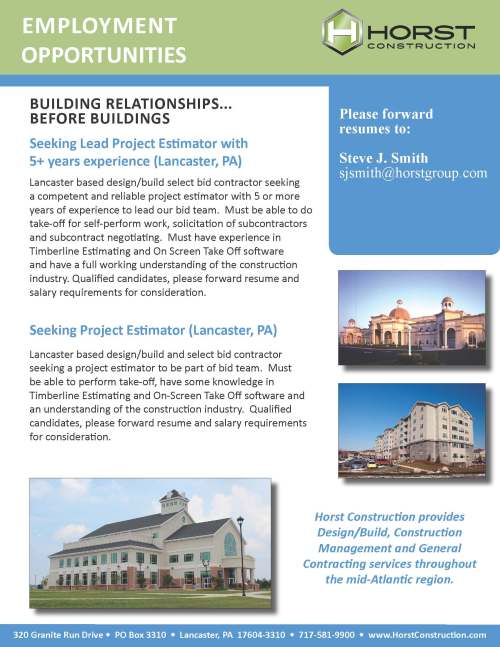Recently I had the pleasure of listening to Kim Miller of Sight & Sound Theatres describe the history and the inspiration behind the family business. As one of the daughters of founder, Glenn Eshelman, she offered a wonderful perspective on the passion and commitment that has played such an important role in the success of the theatre. Her enthusiasm for their new production, Moses, is contagious and I can’t wait to get tickets for the show! Take a behind the scenes look at the production by watching the above video. You can also enjoy Updates 2-6 on their YouTube page that shares additional moments leading up to the premier! Read more about Horst Construction’s involvement in bringing their vision to reality below:
Moses – Sight & Sound Theatre
Filed under Uncategorized
Join Our Team!

Do you or someone you know have experience with Construction Project Estimating? Specifically with Timberline and On Screen Take Off? Email us your resume!
St. Sophia Greek Orthodox Church of Valley Forge
Horst completed the St. Sophia Greek Orthodox Church of Valley Forge project in the spring of 2012. The St. Sophia project uses a very unique 6th Century Byzantine-style architecture that is characterized by soaring domes, cavernous interiors and dazzling mosaics. The centerpiece for the interior was the iconography on the underside of the dome painted by a group of artists from Greece. Dr. George Kordis and his team used an ancient icongraphic technique with traditional egg tempura on special Keim silicate paint that required 5,000 egg yolks! The final results are unique and awe inspiring. It was the first of its kind for us but it won’t be the last! More information soon about our next Greek Church ministry partnership!
Resolving Issues During Construction
I wish I could say that we all live in a perfect world and nothing ever goes wrong, but we all know that isn’t the case. So what do you do when you find yourself stuck with a problem?
I recently had something happen on a project that was quite unexpected and was urgent in nature that would create a very unsafe condition had it not been dealt with quickly and accurately.
So what did I do?
- First, I told the major stakeholders involved about the problem. In this case, those parties are the Owner, design consultants and the contractors directly affected by the issue. You never want to keep an issue a secret and try to figure it out on your own. Even if you know the answer to the problem, it is always best to get it out in the open and discuss it as a team especially if the issue impacts more than yourself.
- Second, was to discuss a resolution with the professional consultants that were on the team. The problem was beyond the Owner and was building related and needed the input of design professionals.
- Lastly, we pulled together a couple options to resolve the problem, presented them to the Owner, and as a team we decided on what would be the win-win resolution.
The problem was successfully resolved and the project continued moving forward.
The next time you find yourself “stuck” with an issue on a construction project it is best to resolve it as a team because you are all in it together.
Filed under Uncategorized
What Is the Purpose of Contingency?
Contingency is an amount of funds set aside in the project budget to cover the things that were missed during the design phase of a project prior to the start of construction. This amount could be set aside by the Owner or Builder, but it has to be defined at the beginning of the project as far as who has ownership of it. Owners and Builders find themselves debating about the contingency during the construction phase if the “ownership” is not clearly defined prior to the start of work.
In the case of a guaranteed maximum price, the Builder often establishes an amount to cover those items, usually very minimal, that he may have missed during the designing and budgeting portion of the project. Mistakes happen and that is why we have a contingency for just such an occasion.
When the Builder sets it aside for his purpose, the Owner technically can’t spend it. When the Owner sets it aside for his purpose the Builder can’t touch it either. Sometimes the contingency is established for use by both parties, but that is decided up front prior to the start of construction. Often times the Owner thinks they can spend the Builders contingency on change orders, but that isn’t correct. The contingency is a method of risk management to cover missed items in the budget that needs to happen on the project and not discretionary funds for the Owner to use when they change their mind about something.
When a contingency is included as part of the project, it is wise to declare the amount up front, what it will be used for and who has ownership of it. That one step will remove all doubt and eliminate the potential for disagreements later in the project regarding the contingency.
Filed under Uncategorized
What Is A Change Order?
Everybody who embarks on a construction project tries to do all the planning they can to avoid change orders during construction. That is always the goal, but sometimes it doesn’t work out that way.
So what is a change order? A change order is simply a change in the scope of the work of the project. It occurs when the Owner changes direction regarding a portion of the project.
Let’s face it; we are a culture of people that thrive on having the latest and greatest things. When something new is introduced to the construction industry, and if the Owner wants that instead of what he is supposed to be getting, he has the right to change his mind. Or, if the Owner realized they missed something, which can happen, they make the correction before the project is completed. A change order will be issued to all parties involved so they know to change direction on the project. Without a change order, the builder does not have the right to divert from the construction documents.
Of course, change orders are more costly during the construction phase of the project because by that time many decisions have been made regarding the project and purchases finalized and sometimes products even shipped. The best time to change one’s mind is when you are in the design phase. It is much easier to move a wall on paper than after it is constructed.
Filed under Uncategorized
Communication, Communication, Communication
The key factor in real estate decisions is location, location, location. The key to successful projects is communication, communication, communication. Ignore that key component of a project and the result is utter CHAOS! Successful project managers spend 90% of their time communicating in one fashion or another.
 This day and age allows many forms of communication whether it be phone, text, email, blog, online social networking or the old fashioned hard copy letter sent via snail mail (which still works by the way).
This day and age allows many forms of communication whether it be phone, text, email, blog, online social networking or the old fashioned hard copy letter sent via snail mail (which still works by the way).
Keeping every stakeholder in the project informed of what is happening at regular intervals is so vitally important. If the communication is lacking then the project is being ignored and not managed properly.
Communication is the backbone to collaboration on the project. Successful projects are always managed by a team that is actively involved in communicating on a regular basis with one another.
Filed under Uncategorized
The Project Is Only As Strong As Your Weakest Subcontractor
What is one of the worst mistakes you could make on a construction project? Give up? Hire an under-qualified subcontractor. When this happens the rest of the project suffers and sometimes even causes project failure. So how do we avoid this problem?
The best advice is to come up with a project specific qualifications list for hiring vendors for the project. These qualifications are above and beyond the project specifications. Project specifications are the written requirements of the scope of work and the general contractor can use that as a means to qualify subcontractors; but going above and beyond that with additional qualifications helps to weed out those who tell you they can do the job and those who can actually do it right. Additional qualification items and practices could look like the following:
- Listing of similar project experience
- Discussing philosophy of project management and staffing
- Request past project Owner references
- Check out the company’s website – This could help answer the previous items
- And don’t forget to discuss their company safety policy!
Projects that focus on hiring contractors based on best value based on qualifications and not just amount of bid sets the project up for success.
Filed under Uncategorized
Kicking Off The Project…Correctly
 There is nothing more important about a construction project than starting off on the right foot. A project requires a lot of planning and preparation and the last thing you want to do is ruin all of the time invested by not giving your best effort at the very beginning.
There is nothing more important about a construction project than starting off on the right foot. A project requires a lot of planning and preparation and the last thing you want to do is ruin all of the time invested by not giving your best effort at the very beginning.
So what does a good project kick-off look like?
Prior to the start of construction, a detailed scope of work and schedule must be developed. Those two elements are critical to getting started. Of course the cost of the project is important, but without knowing what is being done and when it will be completed, you really don’t have a project with a goal in mind.
The scope of work and schedule should be gone over in detail with all stakeholders prior to the start of the project. Any adjustments to those two documents should be made at that time. This often happens at the project kick-off meeting.
It is vital for all stakeholders to be present at the kick-off meeting. This includes the Owner and all subcontractors working on site, and sometimes vendors who are supplying major components to the project.
Clear and concise communication at the beginning of the project with all involved will get your project started off…correctly.
Filed under Uncategorized
The Price Is Right
One of the most challenging and exciting parts of a project is the exercise of putting together the final price to do the job. Those in the industry use the term “bidding” the project. No matter what delivery method you use for your project, the project team will use the process of bidding to arrive at the final price.

So what is involved? The lead estimator assembles the plans and specifications for the project into what is called a “bid package” and sends it out to trades people for the various portions of the project. The trades people review the documents and send a price to the general contractor to do the work in their specialty on or before the day it is due. On “bid day” quotes for the various scopes of work come rushing in the door and are assembled together before the deadline for submission to the Owner.
Each bid is analyzed to determine if the entire scope of work is complete. If it is, it is then considered a qualified bid and that subcontractor could potentially win the project.
This process can be very intense at times because a minor mistake can end up being very costly. That is why a qualified team of professionals work on the bids together so that at the end of bid day they can rest in knowing that the price is right.
Filed under Uncategorized






